Principles of Economics: Analysis of Market Structures and Competition
VerifiedAdded on 2019/11/25
|13
|2844
|146
Report
AI Summary
This report provides a comprehensive analysis of various market structures, including monopoly, monopolistic competition, oligopoly, and pure competition, examining their characteristics and implications. It explores real-world examples such as water companies, fast-food chains (KFC, McDonald's, and Hungry Jack), and universities (Charles Darwin University), illustrating how these entities operate within different competitive environments. The report also delves into the concepts of marginal cost and opportunity cost, explaining their significance in economic decision-making and relating them to the law of diminishing marginal returns. Furthermore, it discusses the impact of factors like pass marks and enrollment rates on the supply and demand of education, providing a detailed understanding of market dynamics within the context of economics.
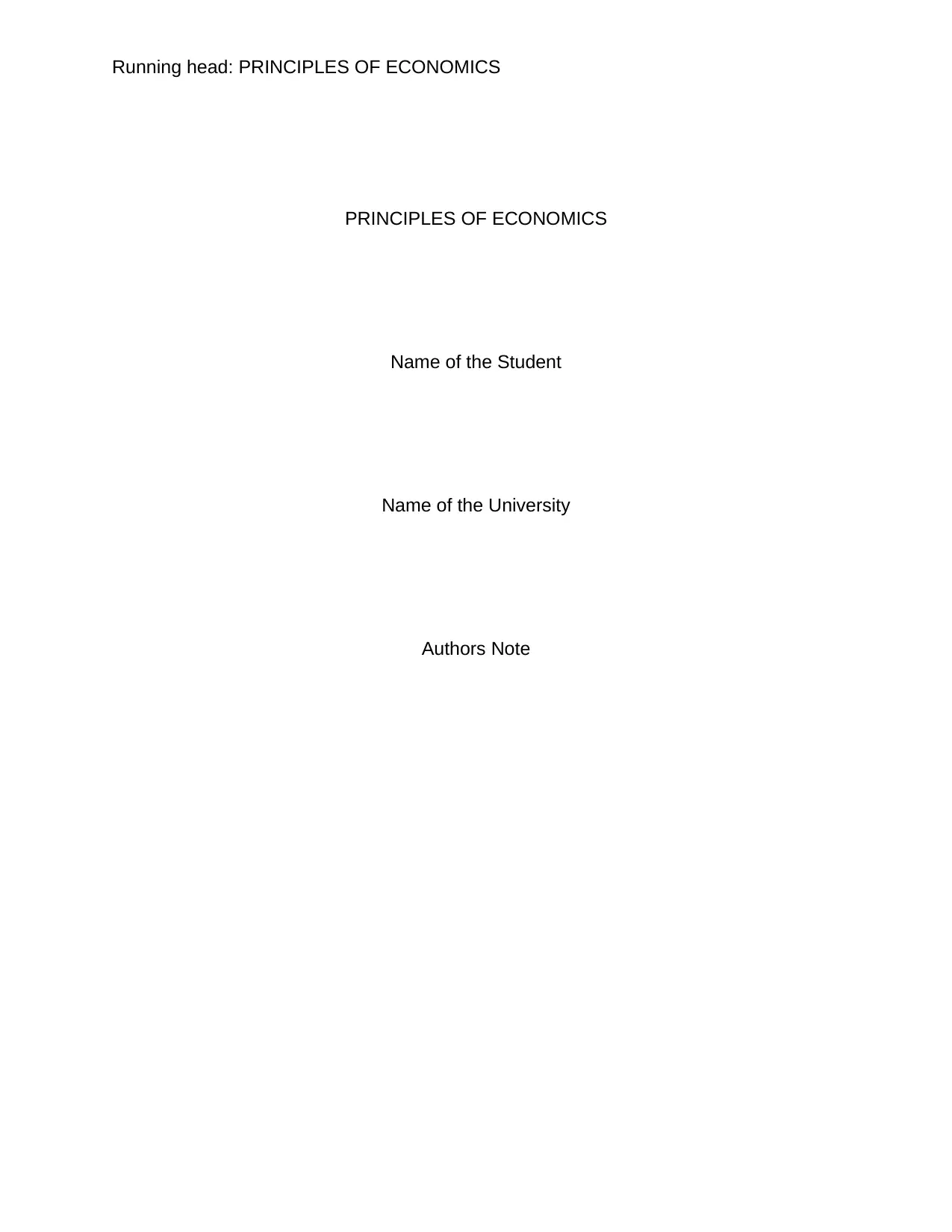
Running head: PRINCIPLES OF ECONOMICS
PRINCIPLES OF ECONOMICS
Name of the Student
Name of the University
Authors Note
PRINCIPLES OF ECONOMICS
Name of the Student
Name of the University
Authors Note
Paraphrase This Document
Need a fresh take? Get an instant paraphrase of this document with our AI Paraphraser
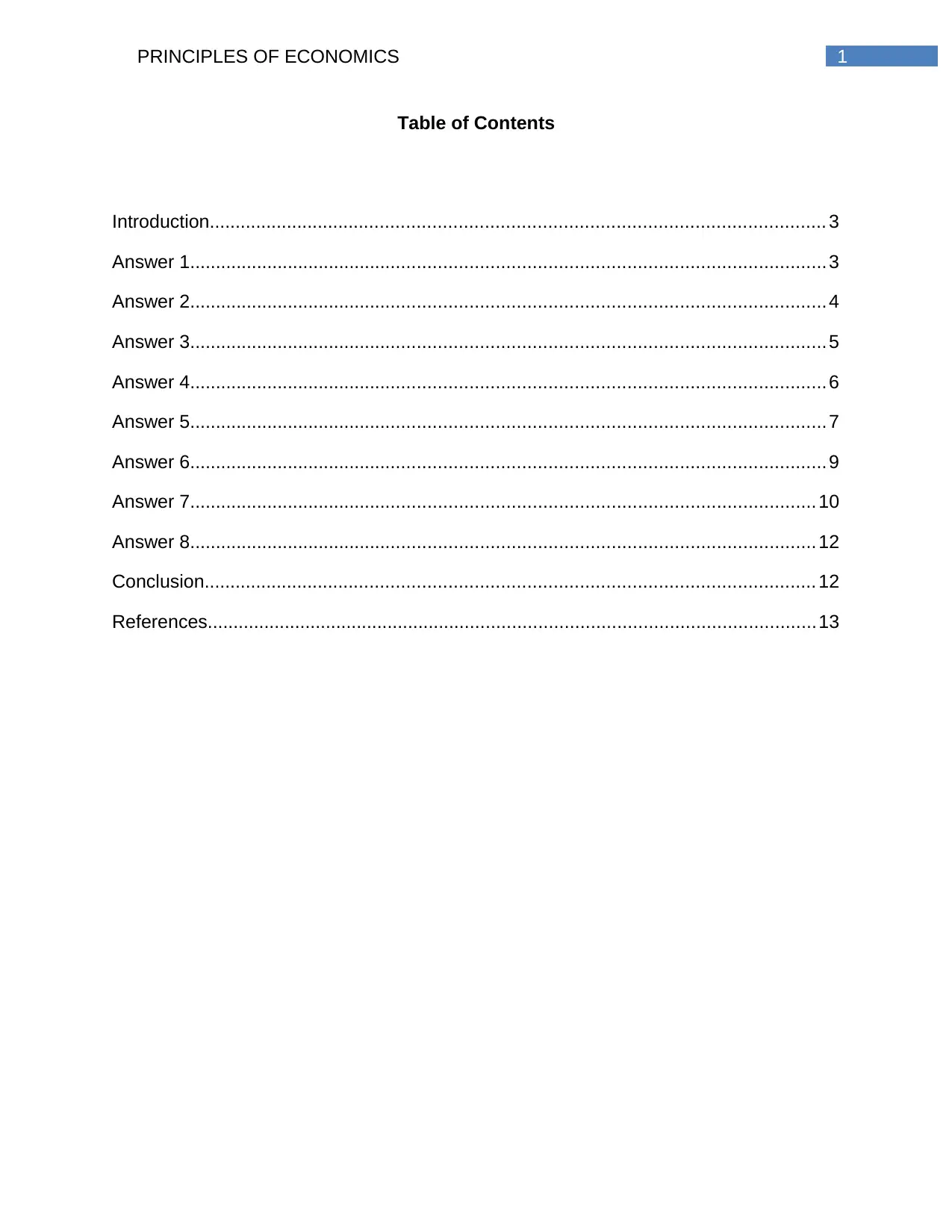
1PRINCIPLES OF ECONOMICS
Table of Contents
Introduction...................................................................................................................... 3
Answer 1.......................................................................................................................... 3
Answer 2.......................................................................................................................... 4
Answer 3.......................................................................................................................... 5
Answer 4.......................................................................................................................... 6
Answer 5.......................................................................................................................... 7
Answer 6.......................................................................................................................... 9
Answer 7........................................................................................................................ 10
Answer 8........................................................................................................................ 12
Conclusion..................................................................................................................... 12
References.....................................................................................................................13
Table of Contents
Introduction...................................................................................................................... 3
Answer 1.......................................................................................................................... 3
Answer 2.......................................................................................................................... 4
Answer 3.......................................................................................................................... 5
Answer 4.......................................................................................................................... 6
Answer 5.......................................................................................................................... 7
Answer 6.......................................................................................................................... 9
Answer 7........................................................................................................................ 10
Answer 8........................................................................................................................ 12
Conclusion..................................................................................................................... 12
References.....................................................................................................................13
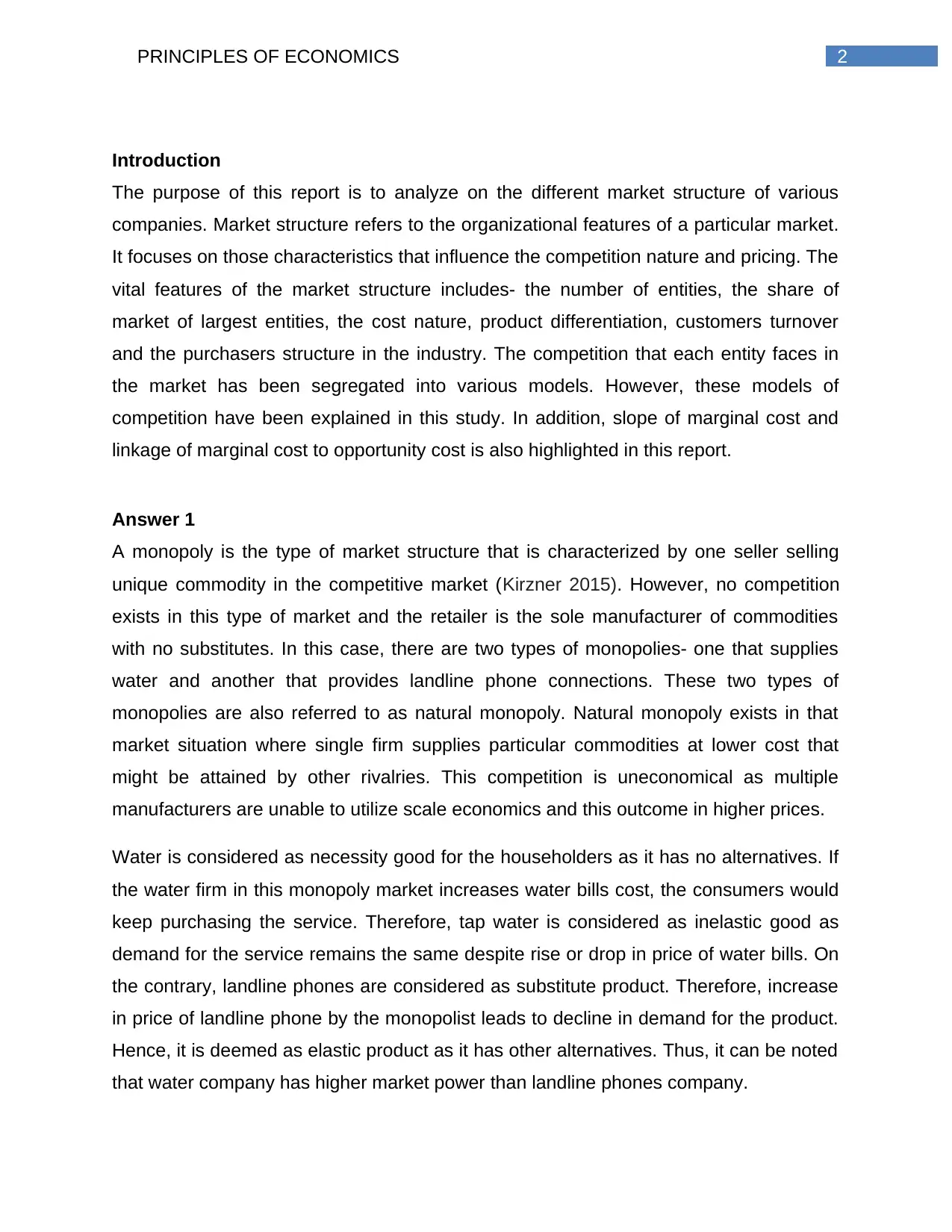
2PRINCIPLES OF ECONOMICS
Introduction
The purpose of this report is to analyze on the different market structure of various
companies. Market structure refers to the organizational features of a particular market.
It focuses on those characteristics that influence the competition nature and pricing. The
vital features of the market structure includes- the number of entities, the share of
market of largest entities, the cost nature, product differentiation, customers turnover
and the purchasers structure in the industry. The competition that each entity faces in
the market has been segregated into various models. However, these models of
competition have been explained in this study. In addition, slope of marginal cost and
linkage of marginal cost to opportunity cost is also highlighted in this report.
Answer 1
A monopoly is the type of market structure that is characterized by one seller selling
unique commodity in the competitive market (Kirzner 2015). However, no competition
exists in this type of market and the retailer is the sole manufacturer of commodities
with no substitutes. In this case, there are two types of monopolies- one that supplies
water and another that provides landline phone connections. These two types of
monopolies are also referred to as natural monopoly. Natural monopoly exists in that
market situation where single firm supplies particular commodities at lower cost that
might be attained by other rivalries. This competition is uneconomical as multiple
manufacturers are unable to utilize scale economics and this outcome in higher prices.
Water is considered as necessity good for the householders as it has no alternatives. If
the water firm in this monopoly market increases water bills cost, the consumers would
keep purchasing the service. Therefore, tap water is considered as inelastic good as
demand for the service remains the same despite rise or drop in price of water bills. On
the contrary, landline phones are considered as substitute product. Therefore, increase
in price of landline phone by the monopolist leads to decline in demand for the product.
Hence, it is deemed as elastic product as it has other alternatives. Thus, it can be noted
that water company has higher market power than landline phones company.
Introduction
The purpose of this report is to analyze on the different market structure of various
companies. Market structure refers to the organizational features of a particular market.
It focuses on those characteristics that influence the competition nature and pricing. The
vital features of the market structure includes- the number of entities, the share of
market of largest entities, the cost nature, product differentiation, customers turnover
and the purchasers structure in the industry. The competition that each entity faces in
the market has been segregated into various models. However, these models of
competition have been explained in this study. In addition, slope of marginal cost and
linkage of marginal cost to opportunity cost is also highlighted in this report.
Answer 1
A monopoly is the type of market structure that is characterized by one seller selling
unique commodity in the competitive market (Kirzner 2015). However, no competition
exists in this type of market and the retailer is the sole manufacturer of commodities
with no substitutes. In this case, there are two types of monopolies- one that supplies
water and another that provides landline phone connections. These two types of
monopolies are also referred to as natural monopoly. Natural monopoly exists in that
market situation where single firm supplies particular commodities at lower cost that
might be attained by other rivalries. This competition is uneconomical as multiple
manufacturers are unable to utilize scale economics and this outcome in higher prices.
Water is considered as necessity good for the householders as it has no alternatives. If
the water firm in this monopoly market increases water bills cost, the consumers would
keep purchasing the service. Therefore, tap water is considered as inelastic good as
demand for the service remains the same despite rise or drop in price of water bills. On
the contrary, landline phones are considered as substitute product. Therefore, increase
in price of landline phone by the monopolist leads to decline in demand for the product.
Hence, it is deemed as elastic product as it has other alternatives. Thus, it can be noted
that water company has higher market power than landline phones company.
⊘ This is a preview!⊘
Do you want full access?
Subscribe today to unlock all pages.

Trusted by 1+ million students worldwide
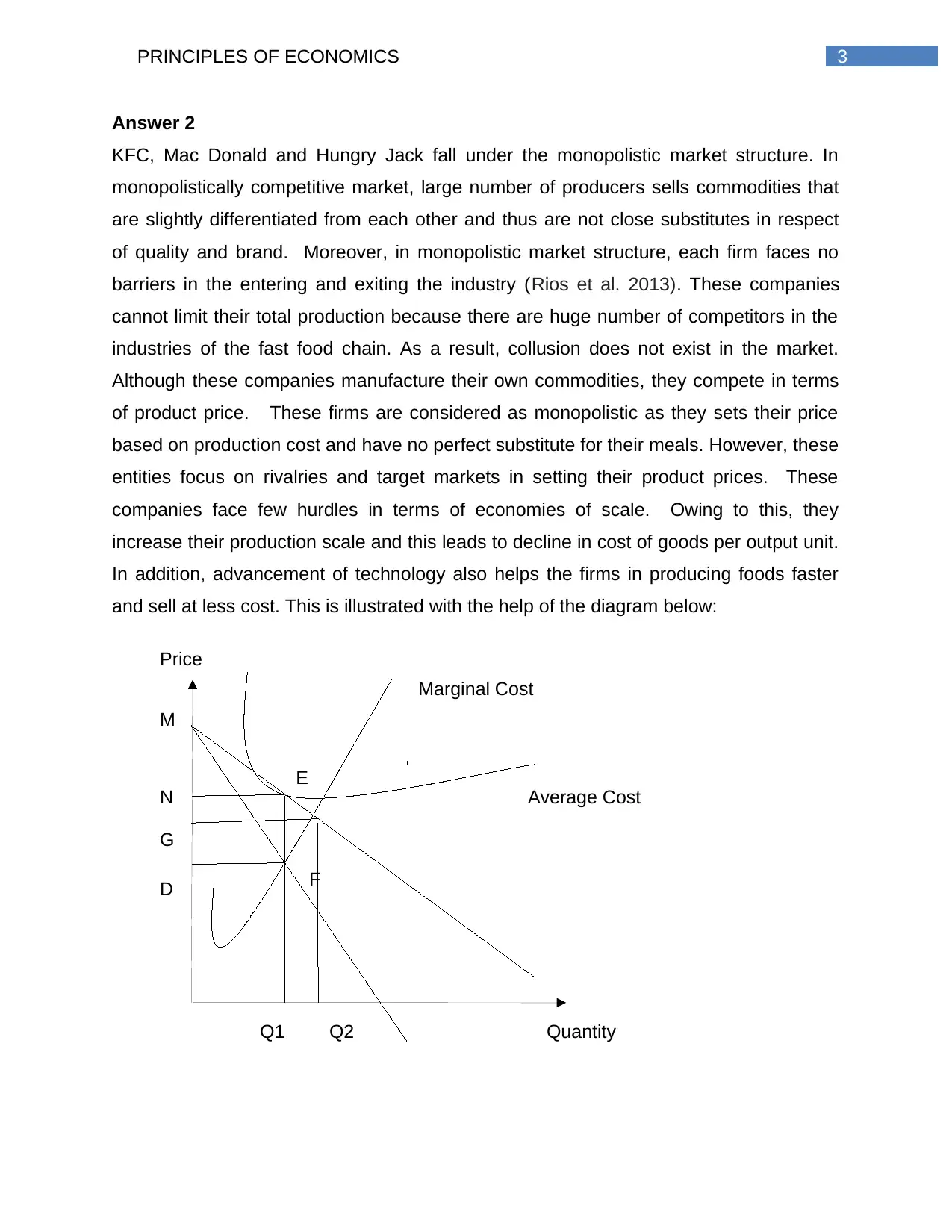
3PRINCIPLES OF ECONOMICS
Quantity
Price
Marginal Cost
Average Cost
M
N
E
G
D F
Q1 Q2
Answer 2
KFC, Mac Donald and Hungry Jack fall under the monopolistic market structure. In
monopolistically competitive market, large number of producers sells commodities that
are slightly differentiated from each other and thus are not close substitutes in respect
of quality and brand. Moreover, in monopolistic market structure, each firm faces no
barriers in the entering and exiting the industry (Rios et al. 2013). These companies
cannot limit their total production because there are huge number of competitors in the
industries of the fast food chain. As a result, collusion does not exist in the market.
Although these companies manufacture their own commodities, they compete in terms
of product price. These firms are considered as monopolistic as they sets their price
based on production cost and have no perfect substitute for their meals. However, these
entities focus on rivalries and target markets in setting their product prices. These
companies face few hurdles in terms of economies of scale. Owing to this, they
increase their production scale and this leads to decline in cost of goods per output unit.
In addition, advancement of technology also helps the firms in producing foods faster
and sell at less cost. This is illustrated with the help of the diagram below:
Quantity
Price
Marginal Cost
Average Cost
M
N
E
G
D F
Q1 Q2
Answer 2
KFC, Mac Donald and Hungry Jack fall under the monopolistic market structure. In
monopolistically competitive market, large number of producers sells commodities that
are slightly differentiated from each other and thus are not close substitutes in respect
of quality and brand. Moreover, in monopolistic market structure, each firm faces no
barriers in the entering and exiting the industry (Rios et al. 2013). These companies
cannot limit their total production because there are huge number of competitors in the
industries of the fast food chain. As a result, collusion does not exist in the market.
Although these companies manufacture their own commodities, they compete in terms
of product price. These firms are considered as monopolistic as they sets their price
based on production cost and have no perfect substitute for their meals. However, these
entities focus on rivalries and target markets in setting their product prices. These
companies face few hurdles in terms of economies of scale. Owing to this, they
increase their production scale and this leads to decline in cost of goods per output unit.
In addition, advancement of technology also helps the firms in producing foods faster
and sell at less cost. This is illustrated with the help of the diagram below:
Paraphrase This Document
Need a fresh take? Get an instant paraphrase of this document with our AI Paraphraser
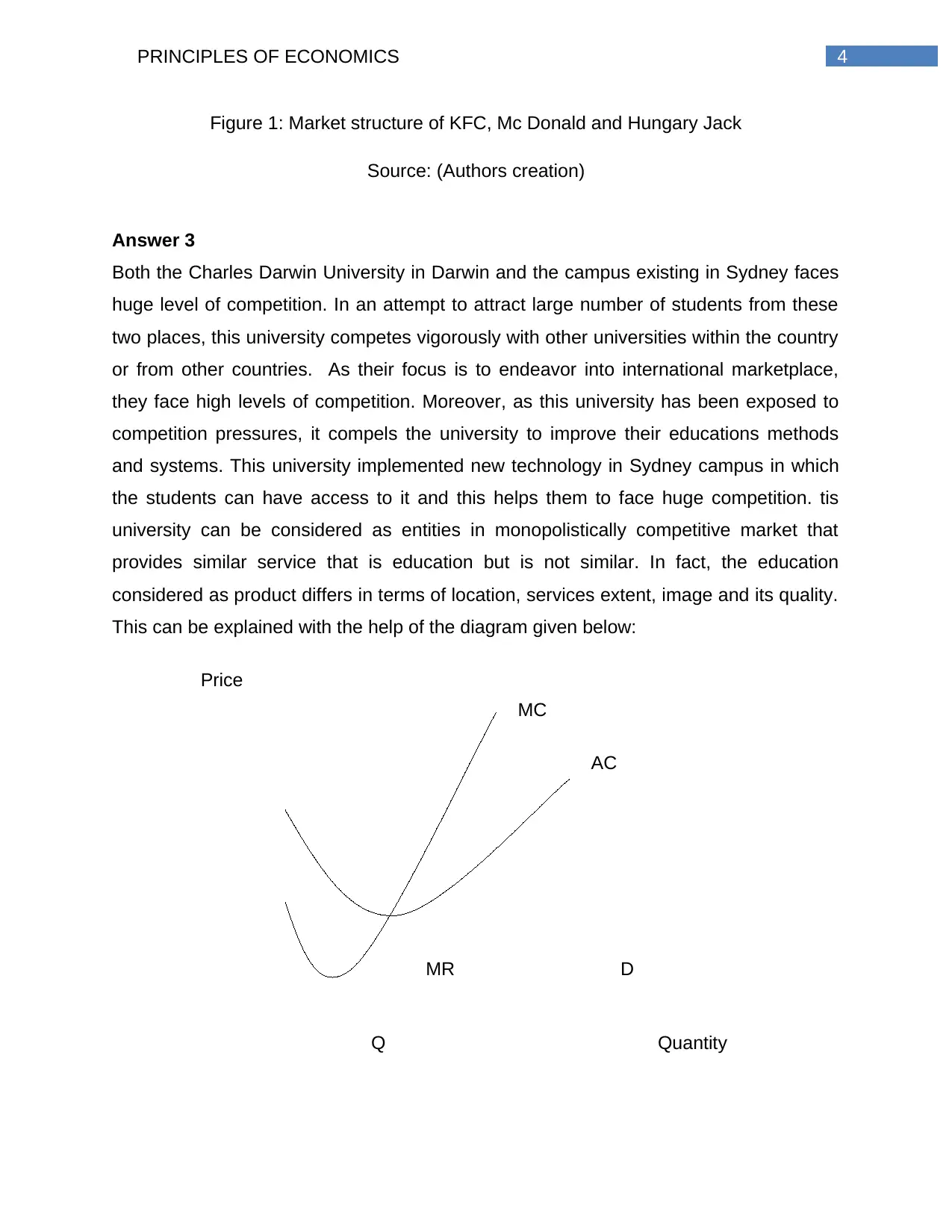
4PRINCIPLES OF ECONOMICS
MC
AC
DMR
Quantity
Price
Q
Figure 1: Market structure of KFC, Mc Donald and Hungary Jack
Source: (Authors creation)
Answer 3
Both the Charles Darwin University in Darwin and the campus existing in Sydney faces
huge level of competition. In an attempt to attract large number of students from these
two places, this university competes vigorously with other universities within the country
or from other countries. As their focus is to endeavor into international marketplace,
they face high levels of competition. Moreover, as this university has been exposed to
competition pressures, it compels the university to improve their educations methods
and systems. This university implemented new technology in Sydney campus in which
the students can have access to it and this helps them to face huge competition. tis
university can be considered as entities in monopolistically competitive market that
provides similar service that is education but is not similar. In fact, the education
considered as product differs in terms of location, services extent, image and its quality.
This can be explained with the help of the diagram given below:
MC
AC
DMR
Quantity
Price
Q
Figure 1: Market structure of KFC, Mc Donald and Hungary Jack
Source: (Authors creation)
Answer 3
Both the Charles Darwin University in Darwin and the campus existing in Sydney faces
huge level of competition. In an attempt to attract large number of students from these
two places, this university competes vigorously with other universities within the country
or from other countries. As their focus is to endeavor into international marketplace,
they face high levels of competition. Moreover, as this university has been exposed to
competition pressures, it compels the university to improve their educations methods
and systems. This university implemented new technology in Sydney campus in which
the students can have access to it and this helps them to face huge competition. tis
university can be considered as entities in monopolistically competitive market that
provides similar service that is education but is not similar. In fact, the education
considered as product differs in terms of location, services extent, image and its quality.
This can be explained with the help of the diagram given below:
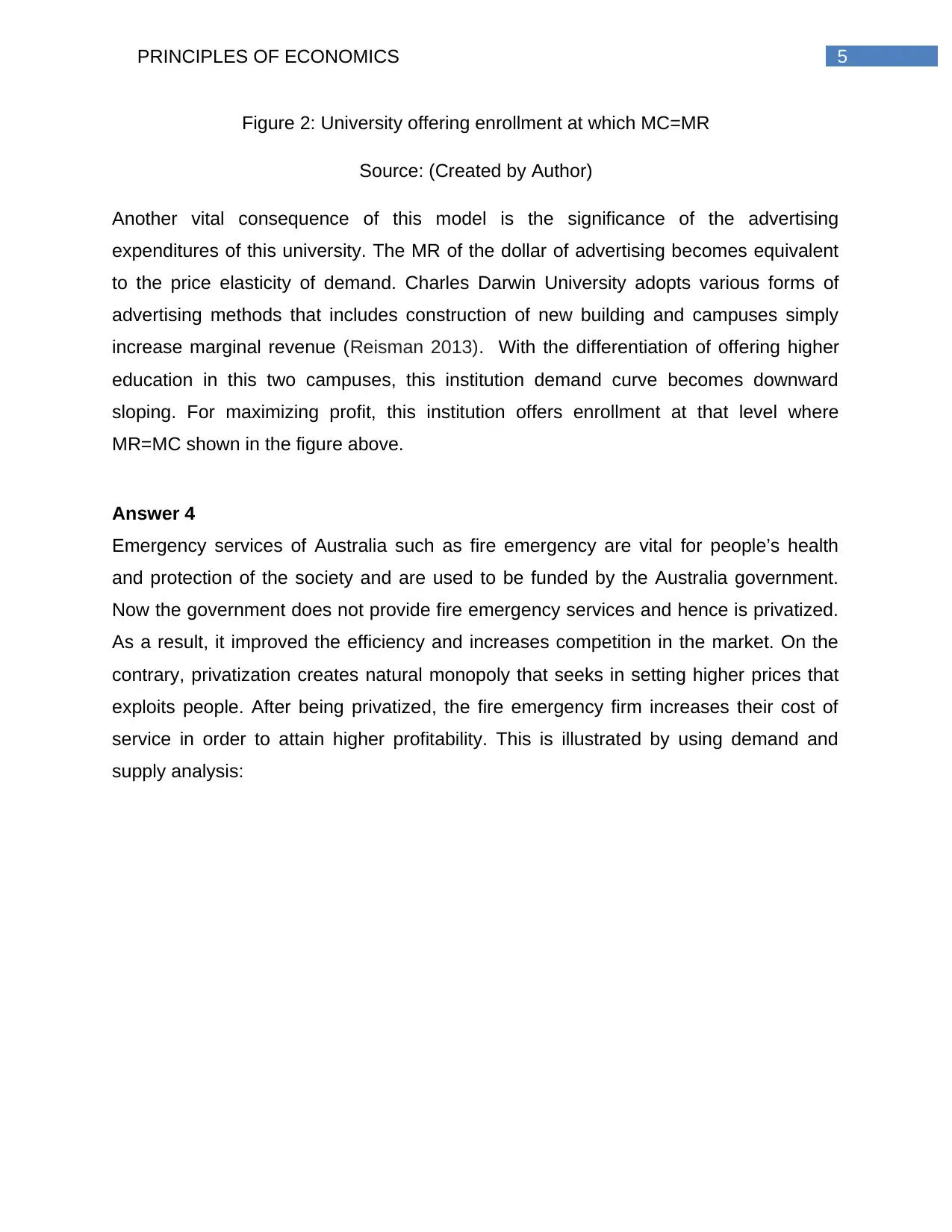
5PRINCIPLES OF ECONOMICS
Figure 2: University offering enrollment at which MC=MR
Source: (Created by Author)
Another vital consequence of this model is the significance of the advertising
expenditures of this university. The MR of the dollar of advertising becomes equivalent
to the price elasticity of demand. Charles Darwin University adopts various forms of
advertising methods that includes construction of new building and campuses simply
increase marginal revenue (Reisman 2013). With the differentiation of offering higher
education in this two campuses, this institution demand curve becomes downward
sloping. For maximizing profit, this institution offers enrollment at that level where
MR=MC shown in the figure above.
Answer 4
Emergency services of Australia such as fire emergency are vital for people’s health
and protection of the society and are used to be funded by the Australia government.
Now the government does not provide fire emergency services and hence is privatized.
As a result, it improved the efficiency and increases competition in the market. On the
contrary, privatization creates natural monopoly that seeks in setting higher prices that
exploits people. After being privatized, the fire emergency firm increases their cost of
service in order to attain higher profitability. This is illustrated by using demand and
supply analysis:
Figure 2: University offering enrollment at which MC=MR
Source: (Created by Author)
Another vital consequence of this model is the significance of the advertising
expenditures of this university. The MR of the dollar of advertising becomes equivalent
to the price elasticity of demand. Charles Darwin University adopts various forms of
advertising methods that includes construction of new building and campuses simply
increase marginal revenue (Reisman 2013). With the differentiation of offering higher
education in this two campuses, this institution demand curve becomes downward
sloping. For maximizing profit, this institution offers enrollment at that level where
MR=MC shown in the figure above.
Answer 4
Emergency services of Australia such as fire emergency are vital for people’s health
and protection of the society and are used to be funded by the Australia government.
Now the government does not provide fire emergency services and hence is privatized.
As a result, it improved the efficiency and increases competition in the market. On the
contrary, privatization creates natural monopoly that seeks in setting higher prices that
exploits people. After being privatized, the fire emergency firm increases their cost of
service in order to attain higher profitability. This is illustrated by using demand and
supply analysis:
⊘ This is a preview!⊘
Do you want full access?
Subscribe today to unlock all pages.

Trusted by 1+ million students worldwide
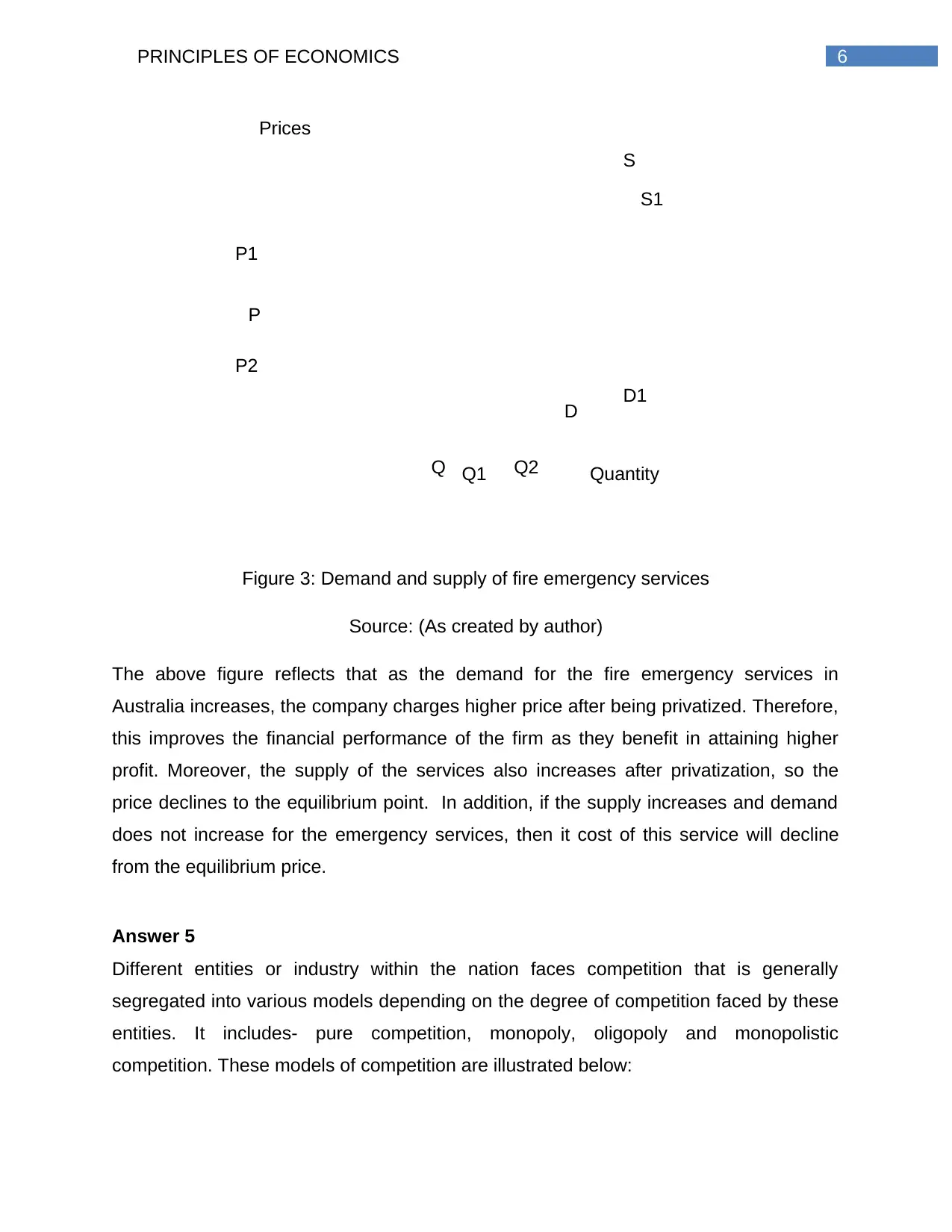
6PRINCIPLES OF ECONOMICS
Quantity
Prices
P1
P
Q Q1
D1
D
S
P2
S1
Q2
Figure 3: Demand and supply of fire emergency services
Source: (As created by author)
The above figure reflects that as the demand for the fire emergency services in
Australia increases, the company charges higher price after being privatized. Therefore,
this improves the financial performance of the firm as they benefit in attaining higher
profit. Moreover, the supply of the services also increases after privatization, so the
price declines to the equilibrium point. In addition, if the supply increases and demand
does not increase for the emergency services, then it cost of this service will decline
from the equilibrium price.
Answer 5
Different entities or industry within the nation faces competition that is generally
segregated into various models depending on the degree of competition faced by these
entities. It includes- pure competition, monopoly, oligopoly and monopolistic
competition. These models of competition are illustrated below:
Quantity
Prices
P1
P
Q Q1
D1
D
S
P2
S1
Q2
Figure 3: Demand and supply of fire emergency services
Source: (As created by author)
The above figure reflects that as the demand for the fire emergency services in
Australia increases, the company charges higher price after being privatized. Therefore,
this improves the financial performance of the firm as they benefit in attaining higher
profit. Moreover, the supply of the services also increases after privatization, so the
price declines to the equilibrium point. In addition, if the supply increases and demand
does not increase for the emergency services, then it cost of this service will decline
from the equilibrium price.
Answer 5
Different entities or industry within the nation faces competition that is generally
segregated into various models depending on the degree of competition faced by these
entities. It includes- pure competition, monopoly, oligopoly and monopolistic
competition. These models of competition are illustrated below:
Paraphrase This Document
Need a fresh take? Get an instant paraphrase of this document with our AI Paraphraser
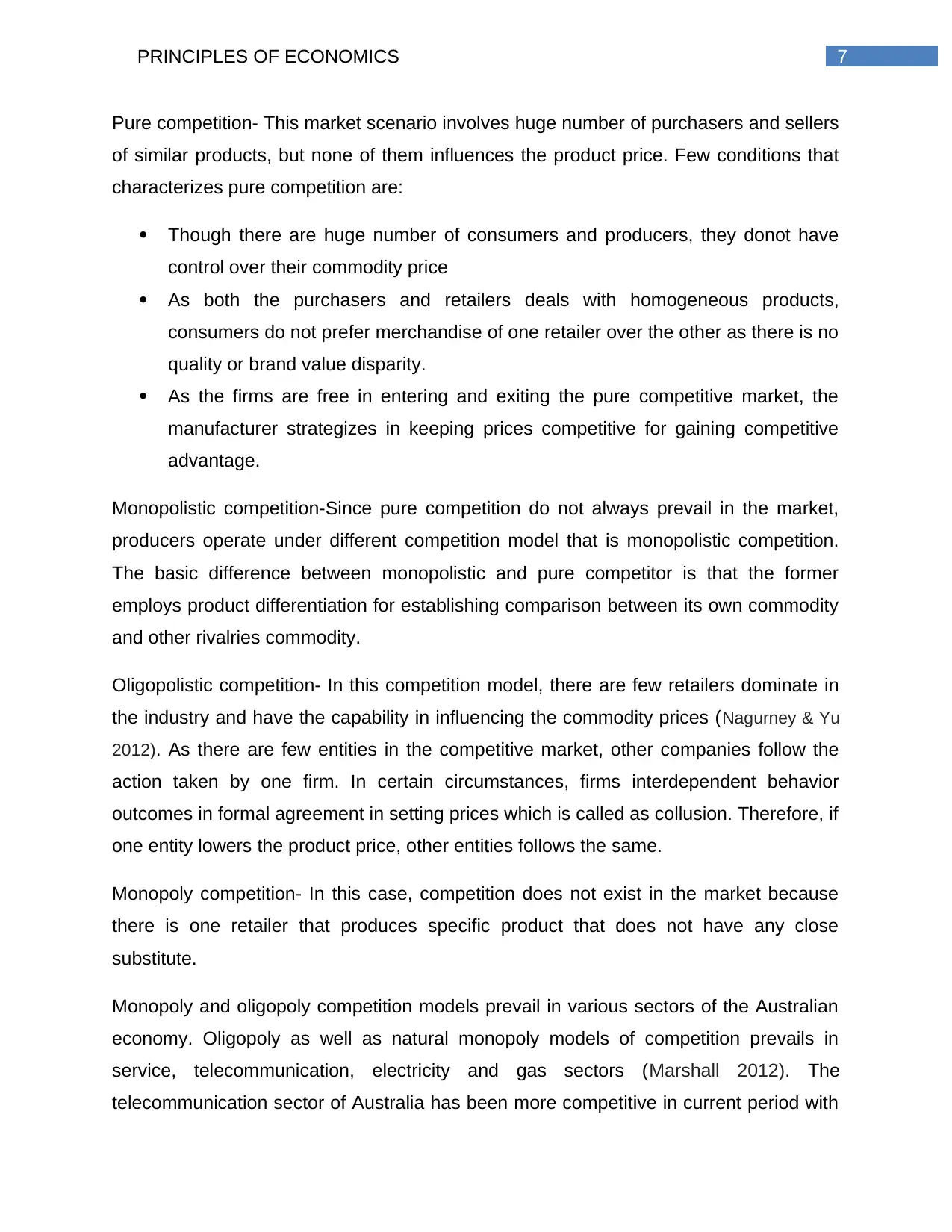
7PRINCIPLES OF ECONOMICS
Pure competition- This market scenario involves huge number of purchasers and sellers
of similar products, but none of them influences the product price. Few conditions that
characterizes pure competition are:
Though there are huge number of consumers and producers, they donot have
control over their commodity price
As both the purchasers and retailers deals with homogeneous products,
consumers do not prefer merchandise of one retailer over the other as there is no
quality or brand value disparity.
As the firms are free in entering and exiting the pure competitive market, the
manufacturer strategizes in keeping prices competitive for gaining competitive
advantage.
Monopolistic competition-Since pure competition do not always prevail in the market,
producers operate under different competition model that is monopolistic competition.
The basic difference between monopolistic and pure competitor is that the former
employs product differentiation for establishing comparison between its own commodity
and other rivalries commodity.
Oligopolistic competition- In this competition model, there are few retailers dominate in
the industry and have the capability in influencing the commodity prices (Nagurney & Yu
2012). As there are few entities in the competitive market, other companies follow the
action taken by one firm. In certain circumstances, firms interdependent behavior
outcomes in formal agreement in setting prices which is called as collusion. Therefore, if
one entity lowers the product price, other entities follows the same.
Monopoly competition- In this case, competition does not exist in the market because
there is one retailer that produces specific product that does not have any close
substitute.
Monopoly and oligopoly competition models prevail in various sectors of the Australian
economy. Oligopoly as well as natural monopoly models of competition prevails in
service, telecommunication, electricity and gas sectors (Marshall 2012). The
telecommunication sector of Australia has been more competitive in current period with
Pure competition- This market scenario involves huge number of purchasers and sellers
of similar products, but none of them influences the product price. Few conditions that
characterizes pure competition are:
Though there are huge number of consumers and producers, they donot have
control over their commodity price
As both the purchasers and retailers deals with homogeneous products,
consumers do not prefer merchandise of one retailer over the other as there is no
quality or brand value disparity.
As the firms are free in entering and exiting the pure competitive market, the
manufacturer strategizes in keeping prices competitive for gaining competitive
advantage.
Monopolistic competition-Since pure competition do not always prevail in the market,
producers operate under different competition model that is monopolistic competition.
The basic difference between monopolistic and pure competitor is that the former
employs product differentiation for establishing comparison between its own commodity
and other rivalries commodity.
Oligopolistic competition- In this competition model, there are few retailers dominate in
the industry and have the capability in influencing the commodity prices (Nagurney & Yu
2012). As there are few entities in the competitive market, other companies follow the
action taken by one firm. In certain circumstances, firms interdependent behavior
outcomes in formal agreement in setting prices which is called as collusion. Therefore, if
one entity lowers the product price, other entities follows the same.
Monopoly competition- In this case, competition does not exist in the market because
there is one retailer that produces specific product that does not have any close
substitute.
Monopoly and oligopoly competition models prevail in various sectors of the Australian
economy. Oligopoly as well as natural monopoly models of competition prevails in
service, telecommunication, electricity and gas sectors (Marshall 2012). The
telecommunication sector of Australia has been more competitive in current period with
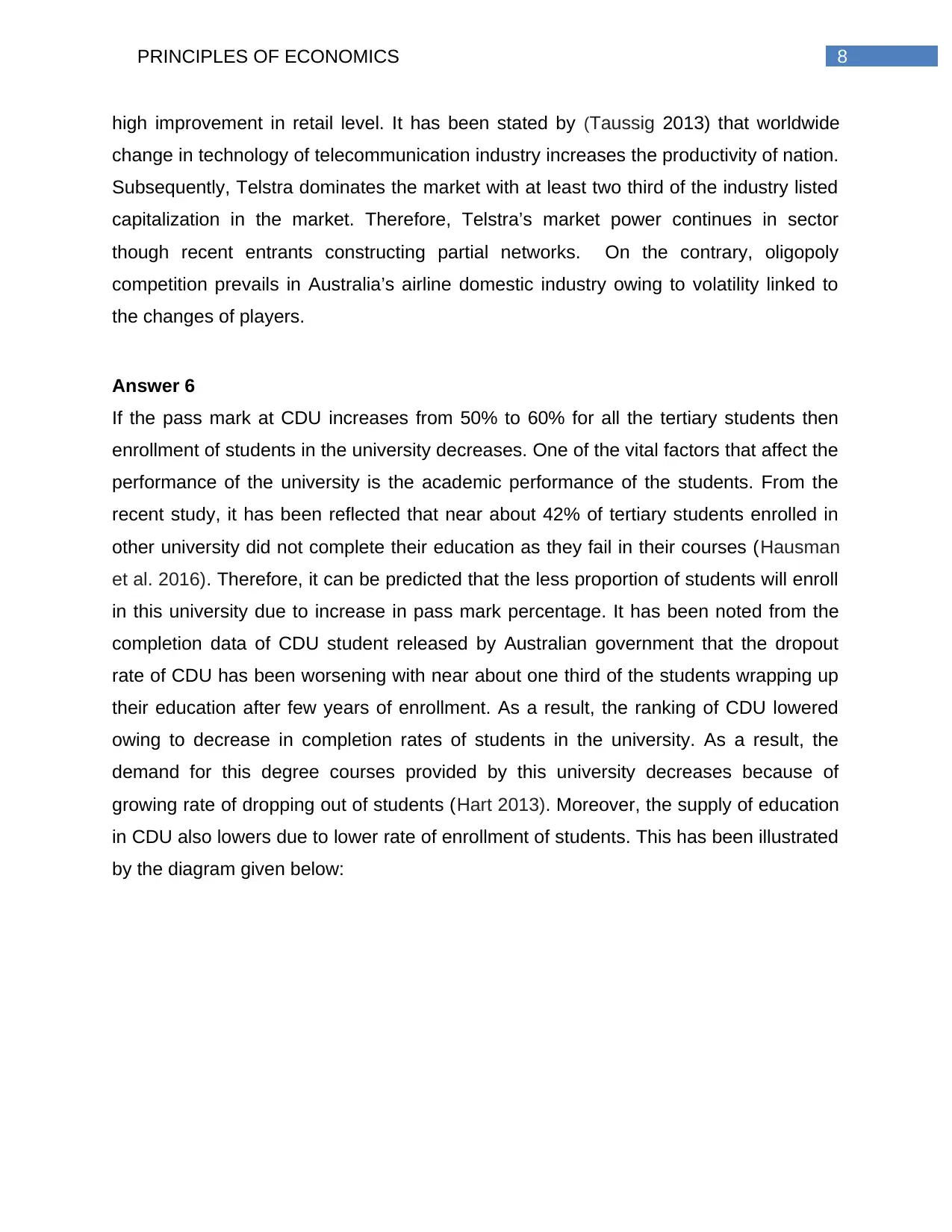
8PRINCIPLES OF ECONOMICS
high improvement in retail level. It has been stated by (Taussig 2013) that worldwide
change in technology of telecommunication industry increases the productivity of nation.
Subsequently, Telstra dominates the market with at least two third of the industry listed
capitalization in the market. Therefore, Telstra’s market power continues in sector
though recent entrants constructing partial networks. On the contrary, oligopoly
competition prevails in Australia’s airline domestic industry owing to volatility linked to
the changes of players.
Answer 6
If the pass mark at CDU increases from 50% to 60% for all the tertiary students then
enrollment of students in the university decreases. One of the vital factors that affect the
performance of the university is the academic performance of the students. From the
recent study, it has been reflected that near about 42% of tertiary students enrolled in
other university did not complete their education as they fail in their courses (Hausman
et al. 2016). Therefore, it can be predicted that the less proportion of students will enroll
in this university due to increase in pass mark percentage. It has been noted from the
completion data of CDU student released by Australian government that the dropout
rate of CDU has been worsening with near about one third of the students wrapping up
their education after few years of enrollment. As a result, the ranking of CDU lowered
owing to decrease in completion rates of students in the university. As a result, the
demand for this degree courses provided by this university decreases because of
growing rate of dropping out of students (Hart 2013). Moreover, the supply of education
in CDU also lowers due to lower rate of enrollment of students. This has been illustrated
by the diagram given below:
high improvement in retail level. It has been stated by (Taussig 2013) that worldwide
change in technology of telecommunication industry increases the productivity of nation.
Subsequently, Telstra dominates the market with at least two third of the industry listed
capitalization in the market. Therefore, Telstra’s market power continues in sector
though recent entrants constructing partial networks. On the contrary, oligopoly
competition prevails in Australia’s airline domestic industry owing to volatility linked to
the changes of players.
Answer 6
If the pass mark at CDU increases from 50% to 60% for all the tertiary students then
enrollment of students in the university decreases. One of the vital factors that affect the
performance of the university is the academic performance of the students. From the
recent study, it has been reflected that near about 42% of tertiary students enrolled in
other university did not complete their education as they fail in their courses (Hausman
et al. 2016). Therefore, it can be predicted that the less proportion of students will enroll
in this university due to increase in pass mark percentage. It has been noted from the
completion data of CDU student released by Australian government that the dropout
rate of CDU has been worsening with near about one third of the students wrapping up
their education after few years of enrollment. As a result, the ranking of CDU lowered
owing to decrease in completion rates of students in the university. As a result, the
demand for this degree courses provided by this university decreases because of
growing rate of dropping out of students (Hart 2013). Moreover, the supply of education
in CDU also lowers due to lower rate of enrollment of students. This has been illustrated
by the diagram given below:
⊘ This is a preview!⊘
Do you want full access?
Subscribe today to unlock all pages.

Trusted by 1+ million students worldwide
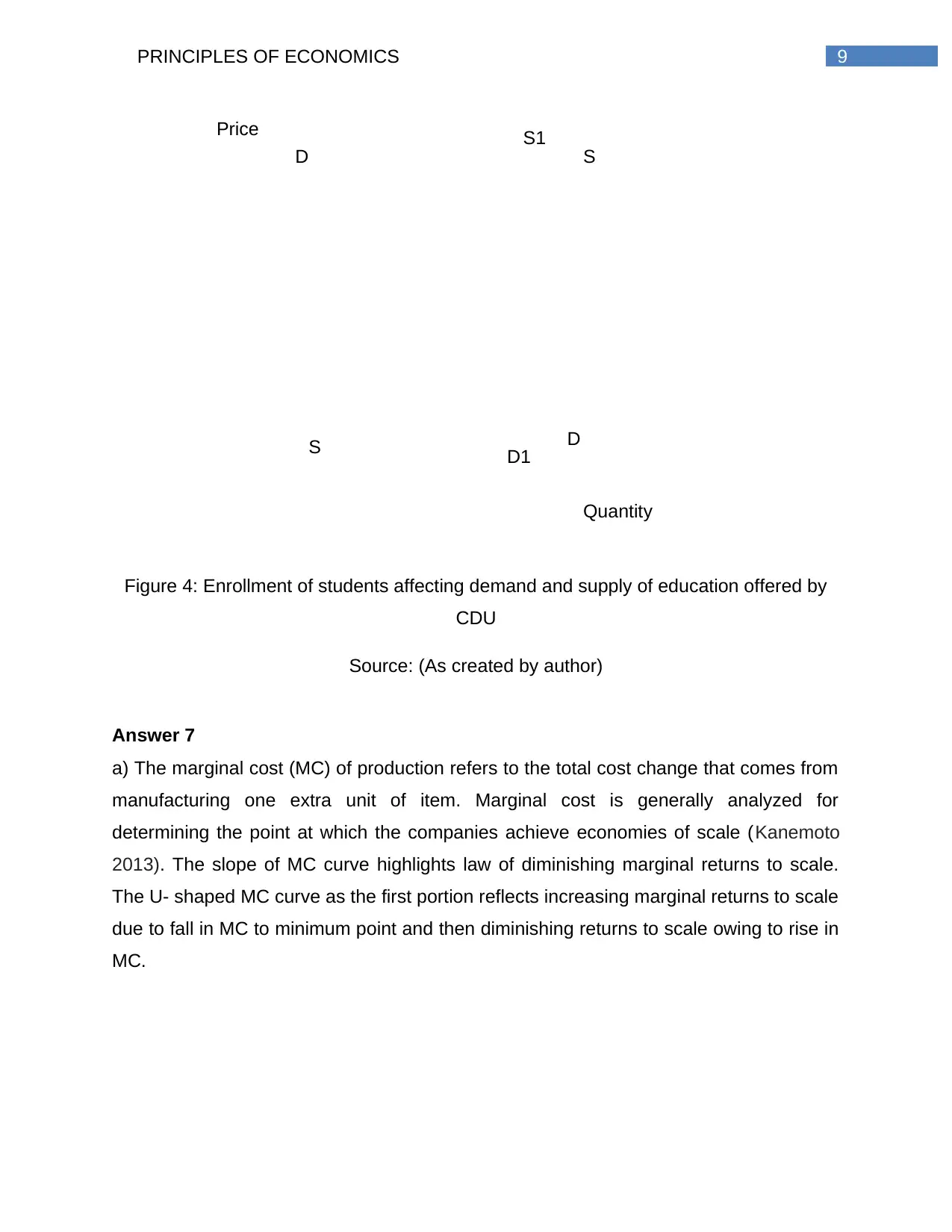
9PRINCIPLES OF ECONOMICS
D
SD
S D1
S1
Quantity
Price
Figure 4: Enrollment of students affecting demand and supply of education offered by
CDU
Source: (As created by author)
Answer 7
a) The marginal cost (MC) of production refers to the total cost change that comes from
manufacturing one extra unit of item. Marginal cost is generally analyzed for
determining the point at which the companies achieve economies of scale (Kanemoto
2013). The slope of MC curve highlights law of diminishing marginal returns to scale.
The U- shaped MC curve as the first portion reflects increasing marginal returns to scale
due to fall in MC to minimum point and then diminishing returns to scale owing to rise in
MC.
D
SD
S D1
S1
Quantity
Price
Figure 4: Enrollment of students affecting demand and supply of education offered by
CDU
Source: (As created by author)
Answer 7
a) The marginal cost (MC) of production refers to the total cost change that comes from
manufacturing one extra unit of item. Marginal cost is generally analyzed for
determining the point at which the companies achieve economies of scale (Kanemoto
2013). The slope of MC curve highlights law of diminishing marginal returns to scale.
The U- shaped MC curve as the first portion reflects increasing marginal returns to scale
due to fall in MC to minimum point and then diminishing returns to scale owing to rise in
MC.
Paraphrase This Document
Need a fresh take? Get an instant paraphrase of this document with our AI Paraphraser
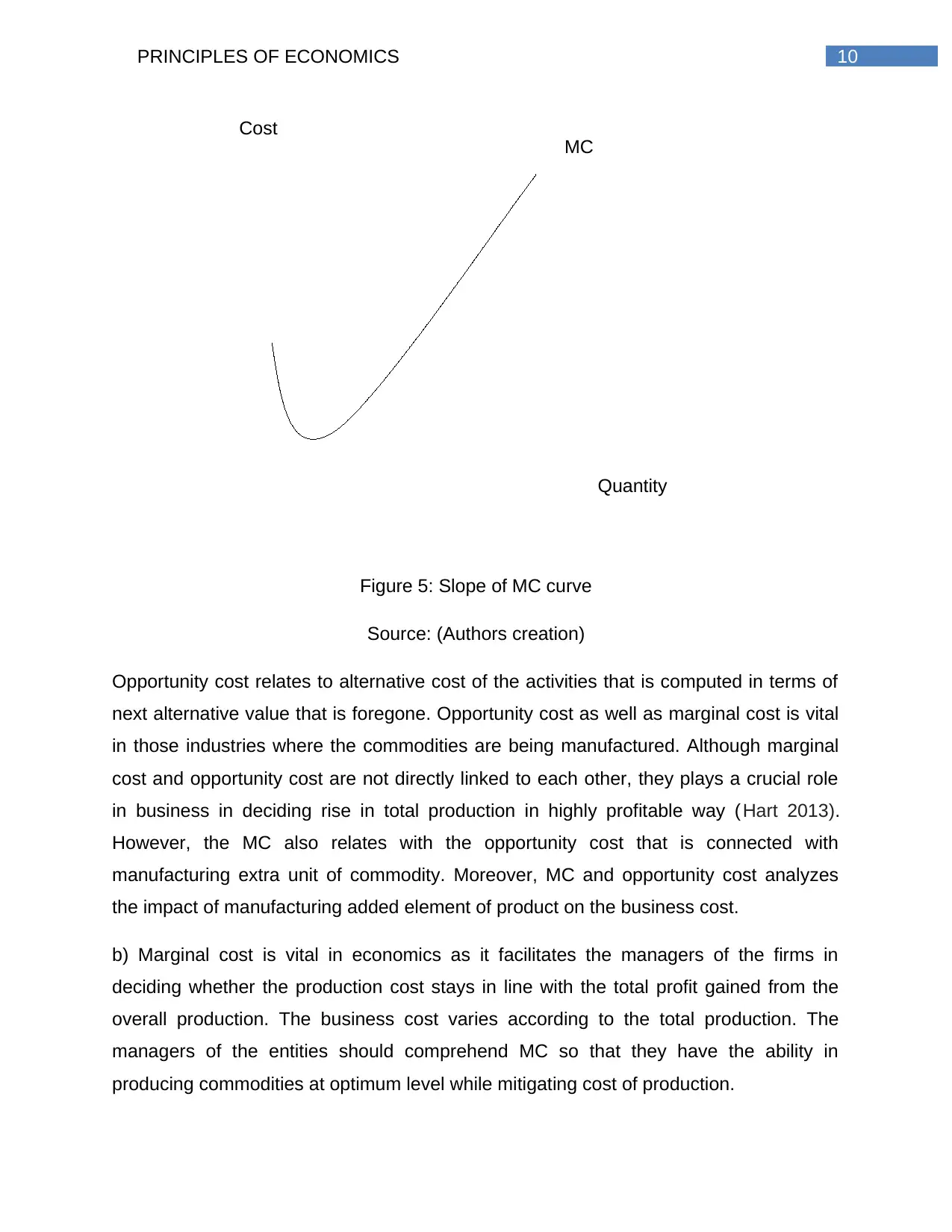
10PRINCIPLES OF ECONOMICS
MC
Quantity
Cost
Figure 5: Slope of MC curve
Source: (Authors creation)
Opportunity cost relates to alternative cost of the activities that is computed in terms of
next alternative value that is foregone. Opportunity cost as well as marginal cost is vital
in those industries where the commodities are being manufactured. Although marginal
cost and opportunity cost are not directly linked to each other, they plays a crucial role
in business in deciding rise in total production in highly profitable way ( Hart 2013).
However, the MC also relates with the opportunity cost that is connected with
manufacturing extra unit of commodity. Moreover, MC and opportunity cost analyzes
the impact of manufacturing added element of product on the business cost.
b) Marginal cost is vital in economics as it facilitates the managers of the firms in
deciding whether the production cost stays in line with the total profit gained from the
overall production. The business cost varies according to the total production. The
managers of the entities should comprehend MC so that they have the ability in
producing commodities at optimum level while mitigating cost of production.
MC
Quantity
Cost
Figure 5: Slope of MC curve
Source: (Authors creation)
Opportunity cost relates to alternative cost of the activities that is computed in terms of
next alternative value that is foregone. Opportunity cost as well as marginal cost is vital
in those industries where the commodities are being manufactured. Although marginal
cost and opportunity cost are not directly linked to each other, they plays a crucial role
in business in deciding rise in total production in highly profitable way ( Hart 2013).
However, the MC also relates with the opportunity cost that is connected with
manufacturing extra unit of commodity. Moreover, MC and opportunity cost analyzes
the impact of manufacturing added element of product on the business cost.
b) Marginal cost is vital in economics as it facilitates the managers of the firms in
deciding whether the production cost stays in line with the total profit gained from the
overall production. The business cost varies according to the total production. The
managers of the entities should comprehend MC so that they have the ability in
producing commodities at optimum level while mitigating cost of production.
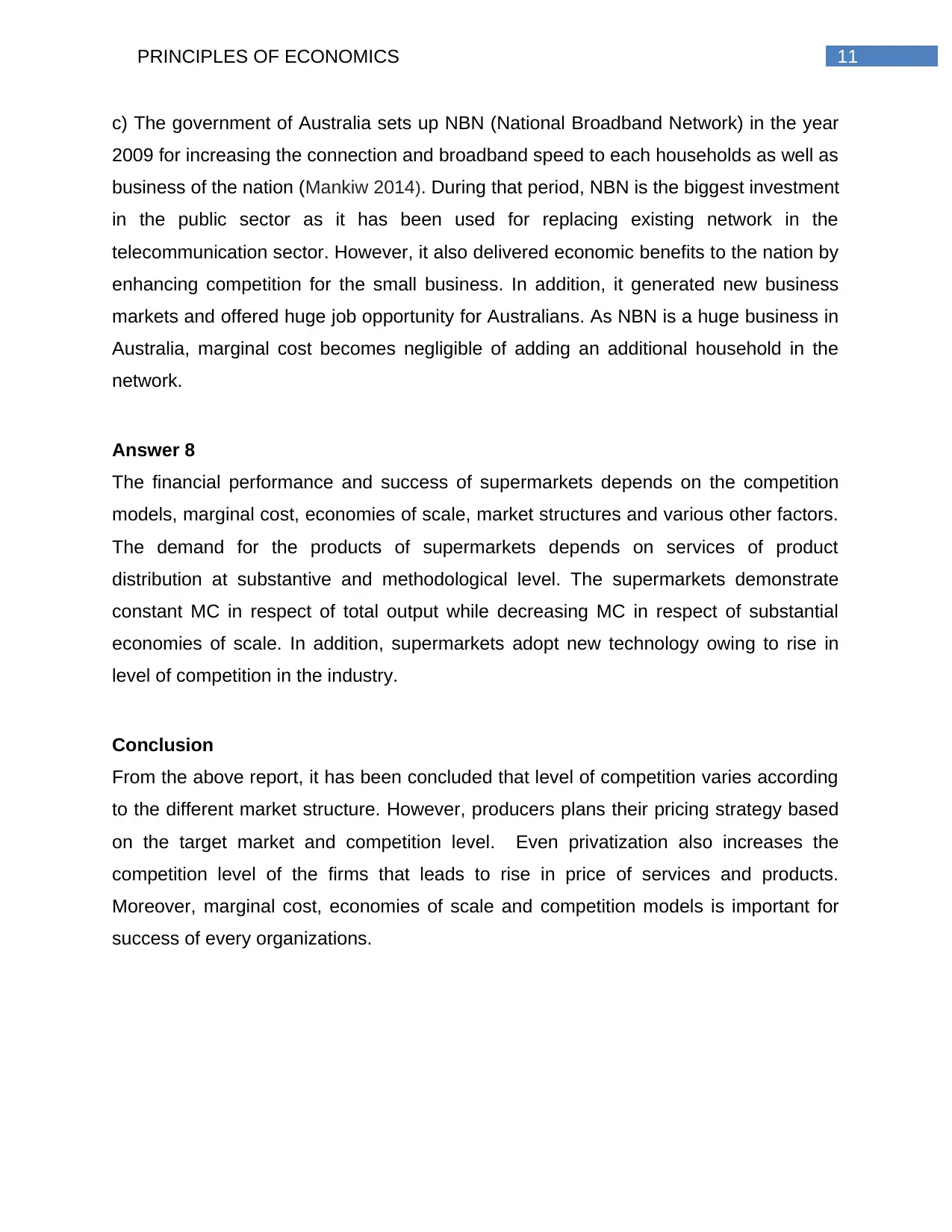
11PRINCIPLES OF ECONOMICS
c) The government of Australia sets up NBN (National Broadband Network) in the year
2009 for increasing the connection and broadband speed to each households as well as
business of the nation (Mankiw 2014). During that period, NBN is the biggest investment
in the public sector as it has been used for replacing existing network in the
telecommunication sector. However, it also delivered economic benefits to the nation by
enhancing competition for the small business. In addition, it generated new business
markets and offered huge job opportunity for Australians. As NBN is a huge business in
Australia, marginal cost becomes negligible of adding an additional household in the
network.
Answer 8
The financial performance and success of supermarkets depends on the competition
models, marginal cost, economies of scale, market structures and various other factors.
The demand for the products of supermarkets depends on services of product
distribution at substantive and methodological level. The supermarkets demonstrate
constant MC in respect of total output while decreasing MC in respect of substantial
economies of scale. In addition, supermarkets adopt new technology owing to rise in
level of competition in the industry.
Conclusion
From the above report, it has been concluded that level of competition varies according
to the different market structure. However, producers plans their pricing strategy based
on the target market and competition level. Even privatization also increases the
competition level of the firms that leads to rise in price of services and products.
Moreover, marginal cost, economies of scale and competition models is important for
success of every organizations.
c) The government of Australia sets up NBN (National Broadband Network) in the year
2009 for increasing the connection and broadband speed to each households as well as
business of the nation (Mankiw 2014). During that period, NBN is the biggest investment
in the public sector as it has been used for replacing existing network in the
telecommunication sector. However, it also delivered economic benefits to the nation by
enhancing competition for the small business. In addition, it generated new business
markets and offered huge job opportunity for Australians. As NBN is a huge business in
Australia, marginal cost becomes negligible of adding an additional household in the
network.
Answer 8
The financial performance and success of supermarkets depends on the competition
models, marginal cost, economies of scale, market structures and various other factors.
The demand for the products of supermarkets depends on services of product
distribution at substantive and methodological level. The supermarkets demonstrate
constant MC in respect of total output while decreasing MC in respect of substantial
economies of scale. In addition, supermarkets adopt new technology owing to rise in
level of competition in the industry.
Conclusion
From the above report, it has been concluded that level of competition varies according
to the different market structure. However, producers plans their pricing strategy based
on the target market and competition level. Even privatization also increases the
competition level of the firms that leads to rise in price of services and products.
Moreover, marginal cost, economies of scale and competition models is important for
success of every organizations.
⊘ This is a preview!⊘
Do you want full access?
Subscribe today to unlock all pages.

Trusted by 1+ million students worldwide
1 out of 13
Related Documents
Your All-in-One AI-Powered Toolkit for Academic Success.
+13062052269
info@desklib.com
Available 24*7 on WhatsApp / Email
![[object Object]](/_next/static/media/star-bottom.7253800d.svg)
Unlock your academic potential
Copyright © 2020–2025 A2Z Services. All Rights Reserved. Developed and managed by ZUCOL.




